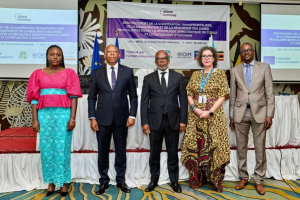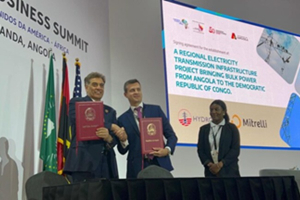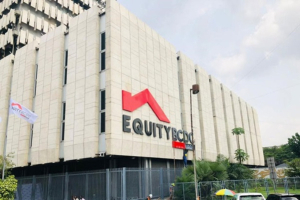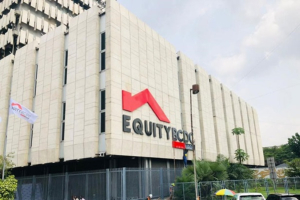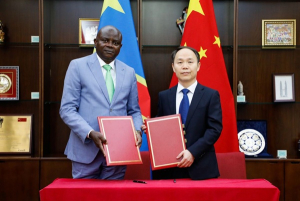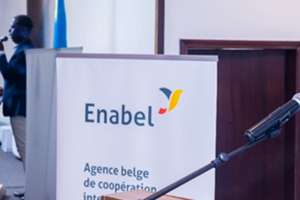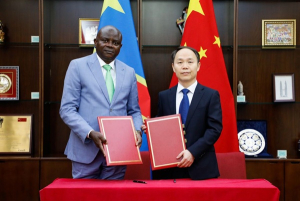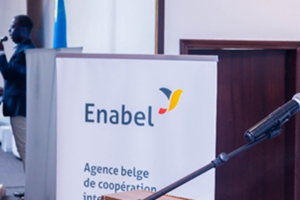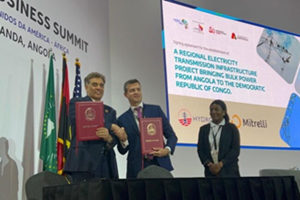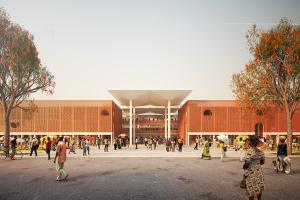Equipe Publication
RDC-Ouganda : 25 millions € pour consolider la paix et l’intégration régionale
Deux projets transfrontaliers entre la République démocratique du Congo (RDC) et l’Ouganda ont officiellement été lancés le 5 juin 2025 à Kinshasa, selon un communiqué publié le lendemain par TradeMark Africa. D’un coût global de 25 millions d’euros (près de 30 millions de dollars au cours actuel), ces projets sont financés par l’Union européenne (UE).
Le premier programme, intitulé « Renforcer la coopération transfrontalière, la stabilisation et la résilience des zones frontalières », est mis en œuvre par l’Organisation internationale pour les migrations (OIM) avec un financement de 15 millions d’euros. Il vise notamment à faciliter la circulation sécurisée des personnes, à améliorer la gestion des flux migratoires, à réduire les tensions communautaires et à soutenir des initiatives locales favorisant la cohésion sociale, en accordant une attention particulière aux femmes et aux jeunes.
Le second projet, « Frontières pacifiques et résilientes II », doté de 10 millions d’euros et coordonné par TradeMark Africa, cible l’amélioration des infrastructures et l’harmonisation des procédures douanières selon les normes de la Communauté de l’Afrique de l’Est (CAE). Il prévoit notamment la modernisation de la route et du pont de Mahagi, ainsi que du port du lac Ntoroko. Ce projet comprend aussi la mise en place de laboratoires mobiles pour garantir la qualité des produits échangés, ainsi que des formations professionnelles destinées aux jeunes.
Prévus sur une durée de trois ans, ces projets s’inscrivent dans le cadre de la stratégie de l’Union européenne pour la stabilité régionale et le développement économique durable dans la région des Grands Lacs. Ils visent à transformer les zones frontalières des deux pays en espaces de paix, de stabilité et de croissance socio-économique inclusive. Ils cherchent également à promouvoir le commerce formel et à renforcer l’implication active des communautés locales dans les dynamiques économiques régionales.
La mise en œuvre de ces projets intervient dans un contexte où la RDC et l’Ouganda se sont engagés à réhabiliter ensemble 1 182 kilomètres de routes pour dynamiser les échanges économiques bilatéraux. Cet engagement fait suite aux accords signés en novembre 2019 entre le président congolais Félix Tshisekedi et son homologue ougandais Yoweri Museveni. La première route relie Goli, ville frontalière de l’Ouganda, à Bunia dans le nord-est de la RDC, en passant par Mahagi. Le second axe part de Mpondwe, à l’ouest de l’Ouganda, pour rejoindre Beni, au nord-est de la RDC. Le troisième corridor relie Bunagana (à la frontière ougandaise) à Goma, en passant par Rutshuru.
Ronsard Luabeya, stagiaire
Lire aussi :
Fraude douanière : Kinshasa saisit l’OMC contre l’Ouganda, le Rwanda, le Kenya et l’Angola
Nord-Kivu : le cacao congolais échappe aux circuits officiels via l’Ouganda
Commerce transfrontalier : des trajets plus longs entre Goma, Bukavu et l’Ouganda
CAE : vers des paiements plus rapides et moins coûteux entre la RDC et sept pays d’ici 2030
Hydro-Link’s $1.5B Angola–DRC Power Line Set to Energize Mining Boom
U.S. based Hydro-Link is leading a $1.5 billion project to build a 1,150 kilometer electricity transmission line connecting Angola and the Democratic Republic of Congo (DRC). The company announced the project at the 17th U.S. Africa Business Summit, hosted by the Corporate Council on Africa, currently underway in Luanda, Angola.
While Hydro-Link remains relatively unknown, its Chief Executive Officer, Paul Hinks, has more than four decades of global experience in developing, financing, and operating power infrastructure. To advance the project, the company is partnering with the Swiss-headquartered Mitrelli Group.
In a joint statement released on June 23, the two firms announced they had signed a memorandum of understanding (MoU), the first of three agreements considered crucial for bringing the project to fruition. A second MoU with the Angolan government was expected to be signed on June 24. Talks are also ongoing with Congolese authorities, according to the Financial Post.
Strong U.S. Footprint
Mitrelli, which has operated in Angola for decades, will serve as both an investor and a strategic partner. The group will provide "end-to-end expertise, from project development and financing to on-the-ground execution," the statement said.
To cover approximately 70% of the project’s cost, Hydro-Link is seeking funding from the U.S. International Development Finance Corporation (DFC). The firm is also seeking support from the U.S. Trade and Development Agency for feasibility studies, and additional backing from the U.S. Export-Import Bank.
This extensive American involvement underpins what Hydro-Link describes as the project’s "strong U.S. footprint." The company plans to source major components from U.S. manufacturers. This is a departure from the industry norm of procuring equipment elsewhere for African infrastructure projects. To that end, it has already signed an MoU with sister company Sargent & Lundy, an energy engineering firm that will serve as owner’s engineer and independent consultant.
Powering the Mining Sector
The line is expected to be operational by 2029, delivering up to 1.2 gigawatts of electricity from Angola’s Lauca hydropower plant and other sources. The energy will supply the Kolwezi mining region in the DRC, targeting companies such as Glencore and Ivanhoe Mines, and potentially new U.S. entrants under a "minerals-for-security" agreement currently under negotiation between Kinshasa and Washington.
Hydro-Link’s initiative marks the third Angola-DRC interconnection project, alongside ventures led by Moroccan group Somagec and a Trafigura-ProMarks consortium. All aim to export Angola’s surplus power to the DRC.
According to the African Development Bank, Angola currently has 1.5 gigawatts of unused clean hydropower capacity, a figure expected to rise to 3.5 gigawatts by 2027. Meanwhile, the DRC’s persistent energy shortages continue to stall the development of key mining projects.
This article was initially published in French by Pierre Mukoko & Ronsard Luabeya
Edited in English by Mouka Mezonlin
Equity BCDC Unions Denounce ‘Disguised Layoffs’ Targeting 460 Employees
The Equity BCDC inter-union has accused the bank of preparing a large-scale, disguised layoff, set to affect nearly 460 employees, which is about 27% of its total workforce at the end of 2023. This accusation appears in a letter dated June 17, 2025, addressed to the Minister of Labor, Ephraim Akwakwa Nametu.
The dispute began after an internal communication on June 6 stated that the parent company, Kenya-based Equity Group Holdings (EGH), suspects these employees of fraud following an internal investigation.
The bank’s management plans to launch a "rigorous and exemplary" disciplinary process, citing a zero-tolerance policy on fraud. However, the unions claim the bank ignored repeated requests for key information—such as the code of conduct, the full list of accused employees, the investigation period, and the alleged fraud amount—before taking action.
Despite receiving no clear answers, the bank reportedly sent explanation requests to the targeted employees starting June 10. In a June 12 letter to Equity BCDC, the inter-union condemned the bank’s "hasty" and "war-like" tactics. This is why the unions are appealing to the Minister of Labor to prevent what they consider to be a purge operation.
Rising Social Tensions
Since January 30, 2025, Equity BCDC and its staff have been in conciliation talks led by the General Labor Inspectorate. This mediation follows the bank’s failure to implement a protocol agreement signed on November 20, 2024, which included retroactive salary alignment from November 1 and the finalization of job classifications.
Unions argue the ongoing disciplinary drive is a maneuver to dodge these social commitments. Equity BCDC’s leadership has not publicly responded in the Democratic Republic of Congo. Earlier in June, Equity Group CEO James Mwangi announced a broad internal probe across subsidiaries after losses of roughly 2 billion Kenyan shillings (about $15.4 million) over two years. The losses allegedly stem from internal fraud involving offshore accounts and M-Pesa wallets.
In May 2025, the group notified 1,200 employees in Kenya of their dismissal as part of similar "purges", giving them 48 hours to prove their innocence. Those who failed faced immediate termination with minimal severance—salary up to the last day, one month’s notice pay, and unused leave compensation minus any debts.
This article was initially published in French by Timothée Manoke
Edited in English by Ange Jason Quenum
Equity BCDC : les syndicats dénoncent un « licenciement déguisé » visant 460 agents
Selon une correspondance datée du 17 juin 2025 adressée au ministre du Travail, Ephraim Akwakwa Nametu, l’intersyndicale d’Equity BCDC accuse la banque de préparer un licenciement massif déguisé. En cause : une communication interne du 6 juin annonçant qu’environ 460 employés soit près de 27 % de l’effectif total à fin 2023 sont soupçonnés de fraude, à la suite d’une enquête menée par la maison mère, Equity Group Holdings (EGH), basée au Kenya.
La direction de la banque aurait prévu d’engager une procédure disciplinaire « rigoureuse et exemplaire » conformément à sa politique de tolérance zéro. Mais les syndicats affirment avoir demandé en vain la communication de plusieurs éléments essentiels avant toute action : code de conduite, liste complète des agents concernés, période couverte par l’enquête, et montant des fraudes alléguées. Faute de réponse, Equity BCDC aurait tout de même adressé, dès le 10 juin, des demandes d’explication aux salariés visés.
Dans un courrier adressé à Equity BCDC le 12 juin, l’intersyndicale fustige une approche « précipitée » et « va-t-en-guerre » de la banque. C’est pourquoi les syndicats en appellent au ministre du Travail pour empêcher ce qu’ils considèrent comme une opération de purge.
Tensions sociales
Depuis le 30 janvier 2025, Equity BCDC et son personnel sont engagés dans un processus de conciliation mené par l’Inspection générale du travail. Cette médiation fait suite à l’inexécution d’un protocole d’accord signé le 20 novembre 2024, prévoyant notamment un alignement salarial avec effet rétroactif au 1er novembre et la finalisation de la classification des emplois. Pour les syndicats, les procédures disciplinaires en cours constituent une manœuvre pour se soustraire à ces engagements sociaux.
En République démocratique du Congo, les dirigent de la banque n’ont pas encore réagi publiquement. Début juin, le PDG de Equity Group, James Mwangi, a annoncé le lancement d’une vaste enquête interne dans l’ensemble de ses filiales, après des pertes évaluées à 2 milliards de shillings kényans (environ 15,4 millions de dollars) sur deux ans, imputées à des fraudes internes, notamment via des comptes offshore et des portefeuilles M-Pesa.
En mai 2025, le groupe avait notifié un licenciement à 1 200 employés au Kenya, leur accordant 48 heures pour prouver leur innocence. À défaut, ils devaient quitter l’entreprise, avec un package minimal : paiement du salaire jusqu’au dernier jour travaillé, indemnité d’un mois de préavis, les jours de congés non pris, et après déduction d’éventuelles dettes envers la banque.
Timothée Manoke, stagiaire
Lire aussi :
Equity : la RDC dans le viseur après 1 200 licenciements pour fraude au Kenya
DR Congo and China Deepen Talks on New Agricultural Cooperation Deals
On June 11, 2025, the Democratic Republic of Congo (DRC) and China signed a memorandum of understanding to expand cooperation in agriculture. The agreement was concluded on the sidelines of the 4th China-Africa Economic and Trade Expo (CAETE) in Changsha, capital of China’s Hunan province. The deal was officially presented on June 20, 2025, during the DRC’s 48th Council of Ministers by Grégoire Mutshail Mutomb, Minister of State for Agriculture and Food Security.
This initial agreement lays the foundation for a future strategic partnership focused on strengthening the DRC’s food sovereignty. It outlines several areas of collaboration, including technical knowledge sharing, development of trade channels for exporting Congolese products, and support for agricultural research through partnerships with Chinese institutions.
The company Modern Agriculture Trading SARL will serve as the technical partner for engaging with China’s Hunan Renjian Woxiang Group to establish bilateral purchasing mechanisms.
Although no implementation timeline was provided, the Council of Ministers has approved the creation of a multisectoral committee to oversee the technical and operational follow-up of the proposed partnership.
This memorandum is part of a series of recent agriculture-related agreements between the DRC and China. In April 2025, a cooperation agreement was signed with Chinese firm Hunan Linshi Agricultural Service Ltd to improve crop and vegetable productivity in the DRC through various initiatives.
In September 2024, the DRC’s Minister of External Trade, Julien Paluku Kahongia, facilitated the signing of a memorandum aimed at exporting more than one million tons of agricultural products from the DRC to China by Congolese producers.
In March 2025, a Chinese delegation visited the DRC’s Ministry of Fisheries and Livestock to begin discussions on a partnership to enable the annual production of five million white-feathered chicks in the country.
Enabel Commits €2.7M to Boost Entrepreneurs’ Credit Access in DRC
The Belgian development agency Enabel announced on June 17, 2025, that it has mobilized €2.7 million (around $3 million) to “sustainably improve” access to financing for entrepreneurs in the Democratic Republic of Congo (DRC). The funding will support a 30-month program implemented in partnership with the Financial Inclusion Fund (FPM ASBL), a multi-donor fund that provides tailored technical assistance to financial institutions serving micro, small, and medium-sized enterprises (MSMEs) and low-income populations.
The initiative aims to develop long-term solutions for inclusive finance and to act as a catalyst for more equitable and participatory economic development. It will focus on strengthening the capacity of financial institutions to tailor their services to the specific needs of entrepreneurs. This includes a particular focus on youth, women, and high-potential SMEs.
In parallel, the program will offer training in business management and financial literacy. This training aims to help entrepreneurs qualify for formal financial services. The program also plans to enhance coordination among local entrepreneurial ecosystem players, with tighter monitoring of partnership initiatives. The program will target six provinces: Kinshasa, Haut-Katanga, Lualaba, Tshopo, Kasaï Oriental, and Sud-Ubangi.
Enabel already operates several initiatives in the DRC to support entrepreneurship. In Lubumbashi and Kolwezi, the Boost Camp program supports 20 SMEs through coaching and training. In Kinshasa, K-Impact assists 100 MSMEs, while Kin Emploi promotes youth employment. In Mbuji-Mayi, the Incubakor initiative backs young project leaders.
Belgium’s 2023 to 2027 bilateral cooperation program with the DRC amounts to €250 million. Enabel is also implementing donor-funded projects worth about €105 million, including funds from the European Union.
Ronsard Luabeya, stagiaire
Agriculture : plusieurs partenariats en gestation entre la RDC et la Chine
Le 11 juin 2025, en marge de la 4 ᵉ Exposition économique et commerciale Chine-Afrique (CAETE) à Changsha, capitale de la province chinoise du Hunan, la République démocratique du Congo (RDC) et la République populaire de Chine ont signé un mémorandum d’entente visant à renforcer leur coopération dans le secteur agricole. Ce protocole d’accord a été présenté lors du 48 ᵉ Conseil des ministres tenu le 20 juin 2025 par le ministre d’État à l’Agriculture et à la Sécurité alimentaire, Grégoire Mutshail Mutomb.
Cet accord préliminaire établit les bases d’un partenariat stratégique futur, axé sur le renforcement de la souveraineté alimentaire de la RDC. Il prévoit plusieurs axes de collaboration, notamment l’échange d’expertises techniques, le développement de filières commerciales pour l’exportation de produits congolais, et un appui à la recherche agricole via des partenariats avec des institutions chinoises. La société Modern Agriculture Trading SARL agira comme interlocuteur technique avec le groupe chinois Hunan Renjian Woxiang, en vue de mettre en place des mécanismes d’achats bilatéraux.
Bien qu’aucun échéancier n’ait été précisé, le Conseil des ministres a validé la création d’un comité multisectoriel chargé d’assurer le suivi technique et opérationnel du partenariat en gestation.
Ce mémorandum s’inscrit dans une série d’accords récents entre la RDC et la Chine dans le domaine agricole. En avril 2025, un protocole d’accord a été signé avec la société chinoise Hunan Linshi Agricultural Service Ltd, visant à renforcer la productivité vivrière et maraîchère en RDC à travers plusieurs initiatives concrètes.
En septembre 2024, le ministre du Commerce extérieur, Julien Paluku Kahongia, a supervisé la signature d’un protocole d’accord visant l’exportation de plus d’un million de tonnes de produits agricoles de la RDC vers la Chine par des producteurs congolais.
Par ailleurs, lors d’une visite d’une délégation chinoise au ministère de la Pêche et de l’Élevage en mars 2025, des discussions ont été entamées sur un accord de coopération visant à permettre à la RDC de produire annuellement 5 millions de poussins de poules à plumes blanches.
Boaz Kabeya, stagiaire
Lire aussi :
Aviculture : vers un accord RDC-Chine pour produire 5 millions de poussins par an
Enabel mobilise 2,7 millions € pour améliorer l’accès au crédit des entrepreneurs en RDC
L’Agence belge de coopération internationale (Enabel) a annoncé, dans un communiqué publié le 17 juin 2025, la mobilisation d’une enveloppe de 2,7 millions d’euros (environ 3 millions de dollars) pour « améliorer durablement » l’accès au financement des entrepreneurs en République démocratique du Congo (RDC). Ce financement soutiendra un programme de 30 mois, mis en œuvre conjointement avec le Fonds pour l’inclusion financière (FPM ASBL), un fonds multi-bailleurs fournissant une assistance technique sur mesure aux institutions financières desservant les micro, petites et moyennes entreprises (MPME) ainsi que les populations à faibles revenus.
Les deux partenaires visent à structurer des solutions durables en matière de financement inclusif et à agir comme catalyseurs d’un développement économique plus équitable et participatif. Le programme se concentrera sur le renforcement des capacités des institutions financières afin d’adapter leurs services aux besoins spécifiques des entrepreneurs, en particulier les jeunes, les femmes et les PME à fort potentiel.
Parallèlement, des formations en gestion et en éducation financière seront dispensées aux entrepreneurs pour améliorer leur éligibilité aux services financiers formels. Une meilleure coordination des acteurs de l’écosystème entrepreneurial local est également prévue, avec un suivi renforcé des initiatives partenariales. Le programme cible six provinces : Kinshasa, Haut-Katanga, Lualaba, Tshopo, Kasaï Oriental et Sud-Ubangi.
Enabel déploie déjà plusieurs programmes en RDC pour appuyer les entrepreneurs. À Lubumbashi et Kolwezi, le programme Boost Camp renforce 20 PME par le biais de coaching et de formations. À Kinshasa, K-Impact accompagne 100 MPME, tandis que Kin Emploi favorise l’insertion des jeunes par la création d’emplois. À Mbuji-Mayi, Incubakor soutient les jeunes porteurs de projets.
Le programme bilatéral 2023-2027 de la Belgique en RDC se chiffre à 250 millions d’euros. Enabel met également en œuvre des projets financés par d’autres bailleurs, dont l’Union européenne, pour un total d’environ 105 millions d’euros.
Ronsard Luabeya, stagiaire
Lire aussi :
Investissements : la Belgique presse la RDC de lever les obstacles
Ligne électrique Angola–RDC : l’Américain Hydro-Link porte un projet à 1,5 milliard $
La société américaine Hydro-Link est le promoteur d’un projet de construction d’une ligne de transport d’électricité de 1 150 kilomètres reliant l’Angola à la République démocratique du Congo (RDC), a-t-on appris à l’occasion du 17e Sommet des affaires États-Unis–Afrique du Corporate Council on Africa, qui se tient à Luanda (Angola) depuis le 22 juin 2025.
Bien que son président-directeur général, Paul Hinks, cumule plus de 40 ans d’expérience dans le développement, le financement et l’exploitation d’infrastructures électriques à travers le monde, Hydro-Link reste une entreprise peu connue. Pour mener à bien son projet, estimé à 1,5 milliard de dollars, la société mise sur un partenariat avec le groupe Mitrelli, basé en Suisse.
Dans un communiqué conjoint publié le 23 juin, les deux entreprises annoncent la signature d’un protocole d’accord (MoU). Il s’agit, selon le document, du premier d’une série de trois accords jugés indispensables à la concrétisation du projet. Un deuxième MoU doit être signé ce 24 juin entre Hydro-Link et le gouvernement angolais. Par ailleurs, selon le média américain Financial Post, des discussions sont également en cours avec les autorités congolaises.
« Forte empreinte américaine »
Mitrelli, qui dispose de plusieurs décennies d’expérience en Angola, devra intervenir en tant qu’investisseur et partenaire stratégique. Concrètement, Mitrelli doit apporter à Hydro-Link « une expertise complète, allant du développement de projet au financement, jusqu’à la réalisation sur le terrain », précise le communiqué.
Pour financer environ 70 % du coût total du projet, Hydro-Link envisage de solliciter un prêt auprès de la Development Finance Corporation (DFC), l’agence américaine de financement du développement. L’entreprise espère également obtenir un financement de l’Agence américaine pour le commerce et le développement pour la réalisation des études d’impact, ainsi qu’un appui complémentaire de l’US Export-Import Bank.
Ce dispositif explique pourquoi le promoteur insiste sur la « forte empreinte américaine » du projet. Hydro-Link prévoit en effet de passer d’importantes commandes à des usines situées aux États-Unis, rompant avec la pratique habituelle de s’approvisionner dans d’autres régions du monde pour les projets africains. À ce titre, la société a déjà signé un protocole d’accord avec Sargent & Lundy, une société sœur spécialisée dans l’ingénierie pour le secteur de l’énergie, qui assurera les fonctions d’ingénieur-conseil du maître d’ouvrage et d’ingénieur indépendant.
Énergie pour les mines
La mise en service de la ligne est prévue d’ici à 2029, avec pour objectif de fournir jusqu’à 1,2 gigawatt d’électricité en provenance de la centrale hydroélectrique de Lauca, en Angola, ainsi que d’autres installations. L’énergie sera destinée à alimenter la zone minière de Kolwezi, en RDC. Cette initiative vise notamment à approvisionner des géants miniers comme Glencore et Ivanhoe Mines, ainsi que de futures entreprises américaines, qui pourraient s’implanter dans la région dans le cadre de l’accord « minerais contre sécurité » actuellement en discussion entre Kinshasa et Washington.
Le projet Hydro-Link constitue le troisième projet d’interconnexion électrique entre l’Angola et la RDC. Les deux autres sont portés respectivement par le groupe marocain Somagec, et par un consortium formé de Trafigura et ProMarks. Tous visent à exporter le surplus d’électricité produit en Angola vers la RDC.
Selon la Banque africaine de développement (BAD), l’Angola dispose actuellement de 1,5 GW d’énergie hydroélectrique propre inutilisée, une capacité qui devrait atteindre 3,5 GW d’ici 2027. En parallèle, le déficit énergétique en RDC continue de freiner le développement de nombreux projets miniers.
Pierre Mukoko et Ronsard Luabeya, stagiaire
Lire aussi :
Kamoa-Kakula : le projet Somagec, une alternative pour importer l’électricité d’Angola
Électricité : les premières exportations de l’Angola vers la RDC espérées d’ici 2030
Interconnexion électrique avec Kinshasa : Brazzaville lance ses études de faisabilité
Kinshasa’s Central Market Set to Reopen in Three Months After Years of Delay
Kinshasa’s long-awaited central market, known locally as Zando, is finally nearing completion. Governor Daniel Bumba announced during a site visit on June 21, 2025, that the market could reopen in just over three months. He made the visit alongside members of the Provincial Assembly bureau.
Bumba reported that construction work has reached 90% completion. The remaining tasks include finishing 5,000 market stalls and installing septic tanks and boreholes to guarantee the market’s autonomous water supply.
This announcement comes after rising pressure from traders who recently mobilized to demand the reopening of the market. Authorities closed Zando in January 2021 to launch modernization work, a decision that initially triggered widespread public protests.
The central market overhaul stems from a public-private partnership between the city of Kinshasa and French firm Sogema. Construction was outsourced to the Chinese company SZTC. The project is backed by a $44.5 million loan from Sofibanque.
Although initial plans scheduled completion for November 2023, several factors caused delays. Among them were a late project start and complications linked to the development of access roads.
Despite setbacks, the scale of the market remains impressive. Spread over 80,500 square meters, Zando is expected to house 80,000 stalls, 40 cold rooms, 270 toilets, and 22 units for commercial banks. These figures were released in 2024 by former governor Gentiny Ngobila. He also projected the market could create "over 500,000 jobs."
According to the Public Expenditure Observatory (Odep) and the Congolese League Against Corruption (Licoco), the operating contract grants Sogema control of the market for 25 years. They called this duration “arbitrarily fixed, without prior study on financial, economic profitability, or environmental impact.” In contrast, provincial authorities defend the deal. They point to the quality and durability of the infrastructure, which they estimate has a lifespan of 150 years.
This article was initially published in French by Timothée Manoke (Intern)





